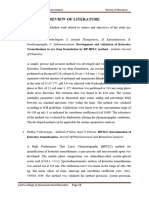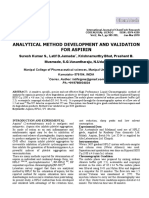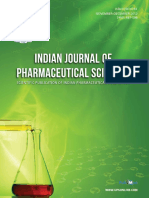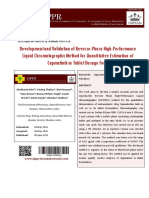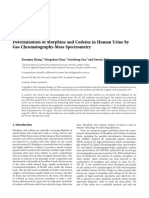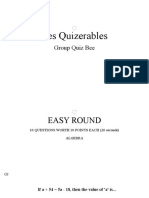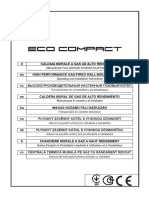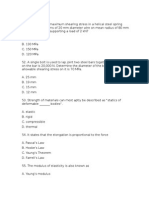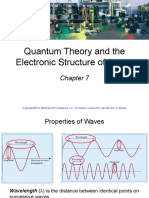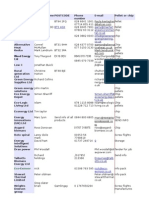Quetiapine Fumarate
Quetiapine Fumarate
Uploaded by
Vinaya SnehalathaCopyright:
Available Formats
Quetiapine Fumarate
Quetiapine Fumarate
Uploaded by
Vinaya SnehalathaOriginal Title
Copyright
Available Formats
Share this document
Did you find this document useful?
Is this content inappropriate?
Copyright:
Available Formats
Quetiapine Fumarate
Quetiapine Fumarate
Uploaded by
Vinaya SnehalathaCopyright:
Available Formats
RJC Rasayan J. Chem Vol.1, No.
3 (2008), 466-474
A VALIDATED STABILITY INDICATING HPLC METHOD FOR
THE DETERMINATION OF RELATED SUBSTANCES IN
QUETIAPINE FUMARATE
S. Radha Krishna1, B.M. Rao1* and N. Someswara Rao2
1*
Analytical Research, Custom Pharmaceutical Services, Dr. Reddy’s Laboratories Ltd.,
Bollaram Road, Miyapur, Hyderabad, 500049 India
2
Head of the Department of Inorganic & Analytical Chemistry, Professor in Analytical
Chemistry, Andhra University, Visakhapattanam - 530 003, India
E-Mail: drbmrao@hotmail.com
ABSTRACT
A simple and accurate reverse phase liquid chromatographic method was developed for the determination
of related substance and degradants of Quetiapine Fumarate bulk drug used as antipsychotic agent for
the management of the manifestations of schizophrenia. Chromatographic separation between
Quetiapine Fumarate its related substances and degradants was obtained from samples generated after
stress degradation. The separation was achieved using a X-bridge C18, 150x4.6 mm, 3.5 μm column,
mobile phase contains 5 mM ammonium Acetate as mobile phase A and Acetonitrile as Mobile phase B
using a binary gradient mode with flow rate of the mobile phase kept at 1.0 ml/min. The sample
concentration was 0.5 mg/ml. The column temperature was maintained at 40°C and the detection
wavelength was 220 nm. The injection volume was 10 μL. The resolution between the critical pair of peaks
(Impurity-B & analyte) was found to be greater than 4.5. The limit of detection (LOD) and limit of
quantification (LOQ) of Impurity-A, Impurity-B and analyte were 27 ng mL-1 and 80 ng/ml, for Impurity-
3 was 14 ng/ml and 40ng/ml respectively, for 10 µl injection volume. The test solution and mobile phase
was observed to be stable up to 24 h after the preparation. The validated method yielded good results of
precision, linearity, accuracy, and robustness. The proposed method was found to be suitable and
accurate for the quantitative determination related substances and degradants during quality control of
Quetiapine Fumarate active pharmaceutical ingredient.
Key words: High performance liquid chromatography,Related substances and degradants ,Validation
and quantification,Quetiapine Fumarate.
INTRODUCTION
Quetiapine Fumarate is described chemically as 11-[4-[2-(2-Hydroxy ethoxy) ethyl]-1-
piperazinyl] dibenzo (b, f) (1, 4) thiazepine hemifumarate (Fig.1). It is one of the recent
“atypical” antipsychotic drug 1 used in treatment of patients with bipolar I disorders.
A liquid chromatography–atmospheric pressure chemical ionization mass spectrometry method
for the quantitative determination of Quetiapine and its metabolites from human plasma samples
was reported in the literature 2. A liquid chromatographic method for the determination of
Quetiapine and fluvoxamine from human plasma using UV detection has been developed and
reported in the literature 3. Two different methods capillary zone electrophoretic (CZE) method
and spectrophotometric method for estimation of Quetiapine in commercial formulations
reported 4. An automated HPLC method with column switching was described for the
determination of Quetiapine, Clozapine, Perazine, Olanzapine and metabolites in blood serum 5.
Two other liquid chromatographic methods were reported using UV and electrochemical
STABILITY INDICATING HPLC METHOD 466 S. Radha Krishna et al.
RJC Rasayan J. Chem Vol.1, No.3 (2008), 466-474
detection for estimation of Quetiapine in plasma samples. 6, 7 So far to our knowledge no stability
indicating HPLC method for determination of related substances of Quetiapine Fumarate has
been reported.
Attempts were made to develop a suitable stability indicating LC method that can be used to
determine the related substances bulk samples of Quetiapine Fumarate. The present work
describes a new, simple and accurate reverse phase liquid chromatographic method for the
detection of the process-related impurities and degradation products generated from forced
degradation studies which may be present in the bulk drug. The developed method was
validated to ensure the compliance in accordance with ICH guidelines.
EXPERIMENTAL
Chemicals and Reagents
Samples of Quetiapine Fumarate and its related substances Impurity-A (Imp.A), Impurity-B
(Imp.B) and Impurity-C (Imp.C) (Fig-2) were received from a business unit of Dr. Reddy’s
Laboratories Ltd., Hyderabad, India.
The HPLC grade acetonitrile was purchased from Rankem fine chemicals, India, Analytical
Reagent grade ammonium Acetate, ammonium formate was purchased from Qualigens fine
chemicals, India , trifluoro acetic acid (TFA) extra pure was purchased from Across organics,
USA and HPLC grade water was produced internally by using Milli-Q, Millipore water
purification system
Instrumentation
The LC system, used for method development and validation was from Agilent 1200 series
(Agilent Technologies Inc., Palo Alto, CA, USA) consists of Quaternary gradient pump, auto
sampler, Column oven and variable wavelength detector. The output signal was monitored and
processed using chemstation software on Pentium computer (Hewlett Packard).
The LC system used in the degradation studies was an Agilent 1100 series (Agilent Technologies
Inc., Palo Alto, CA, USA) equipped with diode array detector. The output signal was monitored
and processed using Chemstation software on Pentium computer (Digital Equipment Co).
Sample preparation
The stock solutions were prepared separately by dissolving the appropriate amounts of the related
substances and compound in diluent, acetonitrile: water, 50:50 (v/v). The target analyte
concentration was fixed as 0.5 mg mL-1.
RESULTS AND DISCUSSION
The objective of this work is to develop suitable stability indicating HPLC method for quantify
related substances and degradation products that were present in Quetiapine Fumarate drug
substance. The mixture of related compounds (Imp.A, Imp.B, Imp.C) and Quetiapine Fumarate
was used in the method development. Different Reverse phase stationary phases were employed
during method development namely Zorbax SB-C8, 250x4.6 mm, 5μm, (Agilent Technologies,
USA), Luna C-18 150x4.6 mm, 3 μm (Phenomenex, USA) ; ACE C-18, 150x4.0 mm, 3 μm (
Advanced chromatographic Technologies, Scotland), Zorbax SB-Phenyl, 150x4.6 mm, 5 μm
(Agilent Technologies, USA), Zorbax SB-C18, 150x4.6 mm, 3.5μm, (Agilent Technologies), and
X-bridge C18, 150x4.6 mm, 3.5 μm ( Waters Corporation, Ireland). Different trails were made
during the method development and the details were mentioned in the Table 1.
STABILITY INDICATING HPLC METHOD 467 S. Radha Krishna et al.
RJC Rasayan J. Chem Vol.1, No.3 (2008), 466-474
Optimized Chromatographic Conditions
Chromatographic separations were achieved only on X-bridge C18, 150x4.6 mm, 3.5 μm column
using the mobile phase contains 5 mM ammonium acetate as mobile A and Acetonitrile as Mobile
phase B in binary gradient using below conditions. Mobile phase composition maintained using
Liner gradient consisting of %B/T: 0/35, 16/35, 25/90, 30/90 with flow rate of the mobile
phase 1.0 ml/min. The test sample concentration was 0.5 mg/ml in diluent, Acetonitrile: water,
50:50 (v/v). The column temperature was maintained at 40°C and the detection wavelength was
220 nm. The injection volume was 10 μL. The total analysis time for each run was 30 min. Good
separations of all impurities and degradants within short run time were observed on X-bridge
C18, 150X4.6 mm 3.5 μm column.
Typical retention times of Imp.A, Imp.B, and Imp.C is 5.5 min., 11.7 min. and 25.0 min.
respectively. The system suitability 8 results were given in Table 2.
Method Validation
Specificity
Specificity is the ability to assess unequivocally the analyte in the presence of components which
may be expected to be present. Typically these might include impurities, degradants, matrix, etc.9
Specificity was tested by injecting the spiked sample of Quetiapine with appropriate levels of
impurities and demonstrating the separation of these impurities individually and/or from other
components in the sample matrix. Moreover, identification of each impurity was confirmed with
retention time as compared with those of pure standards.
Forced degradation studies were performed for bulk drug to provide an indication of the stability
indicating property and specificity of the proposed method. Intentional degradation was
attempted to stress conditions of Photolytic degradation as per ICH Q1B, Thermal degradation
(at 60° C), acid hydrolysis (using 0.5 N HCl), base hydrolysis (using 0.5 N NaOH), and
oxidative degradation (using 3.0% H2O2) to evaluate the ability of the proposed method to
separate Quetiapine from its degradation products. For heat and light studies, study period was
10 days where as for acid, base, and oxidative degradation it was 48 hours. To check and ensure
the homogeneity of Quetiapine peak in the stressed sample solutions, diode array detector was
employed.
Precision
The precision of an analytical procedure expresses the closeness of agreement among a series of
measurements obtained from multiple samplings of the same homogenous sample under
prescribed conditions 9. The system and method precision for 0.5 mg/ml Quetiapine Fumarate
spiked with 0.10% of Imp.A, Imp.B and Imp.C with respect to analyte concentration the
percentage relative standard deviation (%RSD) of method repeatability and system repeatability
for impurities was confirms good precision of the method. Results were given in Table 3
Linearity
The linearity of an analytical procedure is its ability (within a given range) to obtain test results,
which are directly proportional to the concentration of the analyte in the sample 9. The linearity of
the method was checked at six concentration levels i.e. from LOQ to 2500 ng/ml of Imp.A,
Imp.B, Imp.C and Quetiapine Fumarate. The coefficient of regression of the calibration curve
STABILITY INDICATING HPLC METHOD 468 S. Radha Krishna et al.
RJC Rasayan J. Chem Vol.1, No.3 (2008), 466-474
was found to be greater than 0.99, thus confirming the excellent correlation existed between the
peak area and concentration of the impurities
Limit of Detection and Limit of Quantification
The limit of detection (LOD) represents the concentration of analyte that would yield a signal to
noise ratio of 3 9. The limit of detection (LOD) of Imp.A, Imp.B and Imp.C were 27 ng/ml, 27
ng/ml and 14 ng/ml respectively for 10 μl injection volume. The limit of quantification (LOQ)
represents the concentration of analyte that would yield a signal to noise ratio of 10 9. The limit of
quantification (LOQ) of Imp.A, Imp.B and Imp.C were 80 ng/ml, 80 ng/ml and 40 ng/ml for 10
μl injection volume. The precision for Imp-A, Imp-B and Imp-C at LOQ level was good, the
relative standard deviation was found to be below 3.5%.
Accuracy
Standard addition and recovery experiments were conducted to determine the accuracy of the
present method, for the quantification Imp.A, Imp.B and Imp.C. The study was carried out at
LOQ, 0.1, 0.2 0.3, and 0.5 % of target analyte concentration (0.5 mg/ml) of Imp.A, Imp.B and
Imp.C. The percentage recoveries of impurities were ranged from 90.7 to 103.9 in samples of
Quetiapine Fumarate.
Robustness
The robustness of an analytical procedure 9 is measure of its capability to remain unaffected by
small, but deliberate, variations in method parameters and provide an indication of its reliability
during normal usage. In the varied chromatographic conditions viz. flow rate, mobile phase ratio
and column temperature, the resolution between Quetiapine, Imp.A, Imp.B and Imp.C peaks
was found to be > 4.0 illustrating the robustness of the method.
Solution stability and mobile phase stability
Solution stability was studied by keeping the test solution spiked with impurities in tightly capped
volumetric flask at temperature 25o + 2o C on a laboratory bench for 24 h. Content of
impurities was checked for every 6 h interval and compared with freshly prepared solution. No
variation was observed in the content of impurities in sample solutions prepared in diluent were
stable up to 24 h.
Mobile phase stability was carried out by evaluating the content of impurities in sample solution
spiked with impurities, which were prepared freshly at every 6 h for 24 h. The same mobile
phase was used during the study period. No variation was observed in the content of impurities
for the study period and it indicates prepared mobile phase was found to be stable up to 24 h.
CONCLUSION
In this study, the simple, accurate and well-defined stability indicating HPLC method for the
determination of related substances and degradation products in Quetiapine Fumarate was
described. The behavior of Quetiapine Fumarate under various stress conditions were studied and
presented. The information presented herein could be very useful for quality monitoring of bulk
samples and as well employed to check the quality during stability studies
ACKNOWLEDGMENTS
The authors wish to thank the management of Dr. Reddy’s group for supporting this research
work. Authors wish to acknowledge the API group for providing the samples for our research.
STABILITY INDICATING HPLC METHOD 469 S. Radha Krishna et al.
RJC Rasayan J. Chem Vol.1, No.3 (2008), 466-474
Table-1 : Results of different trails
Trial HPLC conditions Remarks number
1 Column: Zorbax SB-C8, 250X4.6 mm, 5μ Poor resolution
Mobile phase: 0.1% v/v TFA in water(MP-A) between Impurities
and 0.1% v/v TFA in Acetonitrile (MP-B) and analyte peaks
Flow rate: 1.0 ml/min, Column temperature: 40 °C
2 Column: Luna C-18 150X4.6 mm, 3 μm Poor resolution
Mobile phase: 0.1% v/v TFA in water between Impurities
and 0.1% v/v TFA in Acetonitrile and analyte peaks
Flow rate: 1.0 ml/min, Column temperature: 40 °C
3 Column: Luna C-18 150X4.6mm, 3 μm
Mobile phase: 10 mM Ammonium Acetate and Poor resolution
(MP-A) and Acetonitrile MP-B) between Imp.B
Flow rate: 1.0 ml/min and analyte
Column temperature: 40 °C Peak shape of Imp.
A is broad
4 Column: ACE C-18, 150X4.0 mm, 3 μm Retention of
Mobile phase :10 mM Ammonium Acetate and Impurity-C is high, (MP-A)
and Acetonitrile MP-B) at high solvent
Flow rate: 1.0 ml/min concentration the
Column temperature: 40 °C resoluton of Imp.B
and analyte is poor
5 Column: Zorbax SB-Phenyl, 150x4.6 mm, 5 μm Peak tailing is
Mobile phase :10 mM Ammonium Acetate and more
(MP-A) and Acetonitrile MP-B)
Flow rate: 1.0 ml/min, Column temperature: 40 °C
6 Column: Zorbax SB-C18, 150X4.6 mm, 3.5μm Resolution between
Mobile phase: 10 mM Ammonium Acetate and Imp.A and Imp.B
(MP-A) and Acetonitrile MP-B) is poor
Flow rate: 1.0 ml/min, Column temperature: 40 °C
7 Column: X-bridge C18, 150X4.6 mm, 3.5 μm AnalytePeak
Mobile phase: 10 mM Ammonium formate shape is poor
(MP-A), Acetonitrile (MP-B)
Flow rate: 1.0 ml/min, Column temperature: 40 °C
8 Column: X-bridge C18, 150X4.6 3.5 μm Drifit in base
Mobile phase: 10 mM AmmoniumAcetate line is high
(MP-A), Acetonitrile (MP-B)
Flow rate: 1.0 ml/min, Column temperature: 40 °C
STABILITY INDICATING HPLC METHOD 470 S. Radha Krishna et al.
RJC Rasayan J. Chem Vol.1, No.3 (2008), 466-474
Table-2:System suitability report
Compound USP USP tailing No. of theoretical plates (N)
Resolution (Rs) USP Tangent method
Impurity-A -- 1.866 8142
Impurity-B 18.694 1.169 12275
Quetiapine 4.588 0.877 11249
Impurity-C 32.134 1.196 370785
Table-3 : Precision results
IMP.A IMP.B IMP.C
Method precision
(%RSD) 1.53 0.66 6.6
System precision
(%RSD) 1.91 1.36 3.71
OH
O
N O
HO
OH
N
N O
Fig-1 : Chemical structures of Quetiapine Fumarate: 11-[4-[2-(2-Hydroxy ethoxy) ethyl]-1-
piperazinyl] dibenzo (b, f) (1, 4) thiazepine hemifumarate
STABILITY INDICATING HPLC METHOD 471 S. Radha Krishna et al.
RJC Rasayan J. Chem Vol.1, No.3 (2008), 466-474
OH
NH
N
N
N
N
N
S S
Impurity-A Impurity-B
N
N
N
N
S
Impurity-C
Fig-2 :Chemical structures of Impurity-A, Impurity -B and Impurity-C
Impurity-A : 11-Piperazinyl-dibenzo(b,f) (1,4)-thiazepine
Impurity-B : 11-[[4-(2-Hydroxyethyl)]-1-piperazinyl] dibenzo [b,f][1,4]thiazepine
Impurity-C : 11-[[4- dibenzo[b,f][1,4]thiazepine-11-yl]piperazinyl]dibenzo[b,f][1,4]thiazepine
REFERENCES
1. M.A. Raggi, R. Mandrioli, V. Pucci and C. Sabbioni, Medicinal Chemistry Reviews -
Online, 1( 3), 299-316, (2004) .
2. Li KY et al, Acta Pharmacol Sin, 25 (1), 110-114, (2004)
3. Maria Addolorata Saracino, Laura Mercolini, Giuseppina Flotta, Lawrence J.
Albers, Roberto Merli and Maria Augusta Raggi- J of Chromatography B, 843(2), 227-
233, ( 2006)
4. Vincenzo Pucci, Roberto Mandrioli, Anna Ferranti, Sandra Furlanetto and
Maria Augusta Raggi, J of Pharmaceutical and Biomedical Analysis
32,( 4-5), 1037-1044, (2003)
5. Julia Sachse, Johannes Köller, Sebastian Härtter and Christoph Hiemke- J of
Chromatography B, l 830( 2), 342-348, (2006).
6. R. Mandrioli , Fanalis, A. Ferranti ,M.A.Raggi : J. Pharm.Biomed. Anal. 30 , 969 –977,
( 2002 )
7. P.C.Davis , J.Wong, O.Gevfert , J. Pharm. Biomed. Anal. ( 1999 )
STABILITY INDICATING HPLC METHOD 472 S. Radha Krishna et al.
RJC Rasayan J. Chem Vol.1, No.3 (2008), 466-474
8. United States Pharmacopeia (2004) Asian edition ,621 , 1225
9. ICH Harmonised Tripartite Guideline on validation of Analytical Procedures:
Q2(R1), November 2005
Fig-3 : HPLC chromatograms of blank run, Impurities spiked (Imp-A, Imp-B and Imp-C) in pure Quetiapine
Fumarate and Quetiapine Fumarate samples
STABILITY INDICATING HPLC METHOD 473 S. Radha Krishna et al.
RJC Rasayan J. Chem Vol.1, No.3 (2008), 466-474
Fig-4: Typical HPLC chromatograms of stressed test samples of Quetiapine Fumarate
(Received: 24 July 2008 Accepted: 2 August 2008 RJC-212)
STABILITY INDICATING HPLC METHOD 474 S. Radha Krishna et al.
You might also like
- A Laboratory Manual of Physical PharmaceuticsFrom EverandA Laboratory Manual of Physical PharmaceuticsRating: 2.5 out of 5 stars2.5/5 (2)
- Physics Lab Stock Verification ReportDocument5 pagesPhysics Lab Stock Verification ReportRaja Doubts100% (5)
- My Professional Career Word 2003 FormattedDocument60 pagesMy Professional Career Word 2003 FormattedErdley100% (1)
- STABILITY INDICATING ASSAY METHOD DEVELOPMENT AND VALIDATION OF PREGABALIN IN PHARMACEUTICAL DOSAGE FORMS BY RP-HPLC P.Sneha, Prathima SrinivasDocument10 pagesSTABILITY INDICATING ASSAY METHOD DEVELOPMENT AND VALIDATION OF PREGABALIN IN PHARMACEUTICAL DOSAGE FORMS BY RP-HPLC P.Sneha, Prathima SrinivasiajpsNo ratings yet
- Research PratikshaDocument8 pagesResearch PratikshaNutan Desai RaoNo ratings yet
- 02.literature RiviewDocument8 pages02.literature RiviewPhariNo ratings yet
- Development and Validation of HPLC Method For The Estimation of Lapatinib in Bulk Drugs and Pharmaceutical FormulationsDocument8 pagesDevelopment and Validation of HPLC Method For The Estimation of Lapatinib in Bulk Drugs and Pharmaceutical FormulationspalkybdNo ratings yet
- 1 s2.0 S0165022X05001119 MainDocument14 pages1 s2.0 S0165022X05001119 MainBivin EbenezerNo ratings yet
- Validarea Aspirinei Prin CromatografieDocument11 pagesValidarea Aspirinei Prin CromatografieStefaniaNo ratings yet
- A Comparative Study For The Quantitative Determination of Paracetamol in Tablets Using UVDocument7 pagesA Comparative Study For The Quantitative Determination of Paracetamol in Tablets Using UVRizqita Atikah SNo ratings yet
- Rasagiline Hemitartrate: Synthesis, Characterization and RP-HPLC Validation For Its Estimation in Bulk FormDocument6 pagesRasagiline Hemitartrate: Synthesis, Characterization and RP-HPLC Validation For Its Estimation in Bulk FormRatnakaram Venkata NadhNo ratings yet
- Development of HPLC Method For The Determination of Zinc Carnosine in Bulk and Dosage FormsDocument5 pagesDevelopment of HPLC Method For The Determination of Zinc Carnosine in Bulk and Dosage FormsSouheila MniNo ratings yet
- Determination and Validation of Benzyl Chloride by HPLC Method in Posaconazole Drug SubstanceDocument7 pagesDetermination and Validation of Benzyl Chloride by HPLC Method in Posaconazole Drug SubstanceUmesha shankra ShettyNo ratings yet
- Mitijps PaperDocument7 pagesMitijps PaperBrijeshkunvar MishraNo ratings yet
- Determination of Spectinomycin Hydrochloride and Its Related Substances by HPLC-ELSD and HPLC-MSDocument5 pagesDetermination of Spectinomycin Hydrochloride and Its Related Substances by HPLC-ELSD and HPLC-MSMichael GaniNo ratings yet
- Method Development and Validation of Paracetamol Drug by RP-HPLC 1Document7 pagesMethod Development and Validation of Paracetamol Drug by RP-HPLC 1Anonymous ncDgoMONo ratings yet
- Amlodipine BesylateDocument6 pagesAmlodipine BesylateOlvi AderineNo ratings yet
- Quantitative Estimation of Gallic Acid in Amla ExtractDocument5 pagesQuantitative Estimation of Gallic Acid in Amla ExtractNarongchai Pongpan100% (1)
- Stress Degradation Studies On Aripiprazole and Development of A Validated Stability Indicating LC MethodDocument6 pagesStress Degradation Studies On Aripiprazole and Development of A Validated Stability Indicating LC Methodblashyrkh_79No ratings yet
- 20 American Journal of Pharmacy and Health ResearchDocument7 pages20 American Journal of Pharmacy and Health Researchk.smilyopenventioNo ratings yet
- JNDC 17 1439Document13 pagesJNDC 17 1439Alah Bacot.No ratings yet
- 20211226124933a5 64 JCM 2108 2174Document11 pages20211226124933a5 64 JCM 2108 2174Venkat PalaganiNo ratings yet
- Article WJPR 1408528531Document9 pagesArticle WJPR 1408528531sripathy84No ratings yet
- Development and Validation of HPLC Method For The Estimation of Nicergoline in Marketed FormulationsDocument5 pagesDevelopment and Validation of HPLC Method For The Estimation of Nicergoline in Marketed FormulationsRatnakaram Venkata NadhNo ratings yet
- Development and Validation of Reversed-Phase HPLC Method For Simultaneous Estimation of Rosuvastatin and Fenofibrate in Tablet Dosage FormDocument6 pagesDevelopment and Validation of Reversed-Phase HPLC Method For Simultaneous Estimation of Rosuvastatin and Fenofibrate in Tablet Dosage FormshraddhaJPNo ratings yet
- Journal Homepage: - : IntroductionDocument10 pagesJournal Homepage: - : IntroductionIJAR JOURNALNo ratings yet
- A Validated Gradient Stability-Indicating LC MethoDocument7 pagesA Validated Gradient Stability-Indicating LC MethoHammam HafidzurahmanNo ratings yet
- Development and Validation of A Reversed Phase HPLC Method For Simultaneous Determination of Curcumin and Piperine in Human Plasma For Application inDocument15 pagesDevelopment and Validation of A Reversed Phase HPLC Method For Simultaneous Determination of Curcumin and Piperine in Human Plasma For Application inMaryem SafdarNo ratings yet
- Simultaneous Determination of Cefotaxime Sodium and Paracetamol by LC-MSDocument7 pagesSimultaneous Determination of Cefotaxime Sodium and Paracetamol by LC-MSIOSR Journal of PharmacyNo ratings yet
- A Validated RP-HPLC Method For The Estimation of Lapatinib in Tablet Dosage Form Using Gemcitabine Hydrochloride As An Internal StandardDocument5 pagesA Validated RP-HPLC Method For The Estimation of Lapatinib in Tablet Dosage Form Using Gemcitabine Hydrochloride As An Internal StandardRatnakaram Venkata NadhNo ratings yet
- Jurnal UtamaDocument4 pagesJurnal UtamaAmaluddinNo ratings yet
- HPLC Method For The Analysis of Paracetamol Caffeine and Dipyron-1Document9 pagesHPLC Method For The Analysis of Paracetamol Caffeine and Dipyron-1Đoàn Lê Thuý HiềnNo ratings yet
- Ojcv028i01p237 241Document5 pagesOjcv028i01p237 241DrVenu Madhav KNo ratings yet
- Macek 2006Document4 pagesMacek 2006Ellie satrianiNo ratings yet
- Estimation of Meropenem in Human Plasma by HPLC-UV and Its Application in Comparative Bioavailability StudyDocument8 pagesEstimation of Meropenem in Human Plasma by HPLC-UV and Its Application in Comparative Bioavailability Studyayand2005No ratings yet
- Simultaneous Determination of Alprazolam With AntihistamineDocument6 pagesSimultaneous Determination of Alprazolam With AntihistaminesamNo ratings yet
- 821 826 PDFDocument6 pages821 826 PDFराजन पाण्डेयNo ratings yet
- Bio 1Document12 pagesBio 1Ismi Wulandari ASNo ratings yet
- J Jtusci 2014 06 001Document7 pagesJ Jtusci 2014 06 001Mohamed Medhat AliNo ratings yet
- AnalysisDocument30 pagesAnalysisSai SaiNo ratings yet
- Development and Validation of Stability Indicating HPLC Method For Determination of Adrenaline TartrateDocument16 pagesDevelopment and Validation of Stability Indicating HPLC Method For Determination of Adrenaline Tartrateloxet71241No ratings yet
- Valporate 3Document7 pagesValporate 3sisnaingaungNo ratings yet
- Metoclopramida DegradacionDocument9 pagesMetoclopramida DegradacionYazminNo ratings yet
- Pre-Column Derivatization Method For DeterminingDocument7 pagesPre-Column Derivatization Method For DeterminingKuanNo ratings yet
- Analytical Method Development and Validation For The Estimation of Metformin and Sitagliptin in Bulk and Tablet Dosage Form by RP-HPLCDocument8 pagesAnalytical Method Development and Validation For The Estimation of Metformin and Sitagliptin in Bulk and Tablet Dosage Form by RP-HPLCBaru Chandrasekhar RaoNo ratings yet
- JournalDocument5 pagesJournalAdjiefhatma FhuwhecxhaNo ratings yet
- Validated RP-HPLC Method For Analysis of Aripiprazole in A FormulationDocument6 pagesValidated RP-HPLC Method For Analysis of Aripiprazole in A Formulationblashyrkh_79No ratings yet
- IbandronateDocument6 pagesIbandronateAashishThakurNo ratings yet
- March April2011 Article6Document5 pagesMarch April2011 Article6Dita SusantiNo ratings yet
- Novel HPLC-UV Method For Simultaneous Determination of Fat-Soluble Vitamins and Coenzyme Q10 in Medicines and SupplementsDocument7 pagesNovel HPLC-UV Method For Simultaneous Determination of Fat-Soluble Vitamins and Coenzyme Q10 in Medicines and Supplementsade muchlasNo ratings yet
- Jurnal HPLCDocument3 pagesJurnal HPLCRiche Dewata S.No ratings yet
- BBRA Vol 21 No 1 P 283-294Document12 pagesBBRA Vol 21 No 1 P 283-294072- Krutarth PatelNo ratings yet
- Ijppr 2021Document16 pagesIjppr 2021Smita NayakNo ratings yet
- Degradation PramipexoleDocument9 pagesDegradation Pramipexoleclaudiamaniac7No ratings yet
- CreatinineDocument3 pagesCreatinineiabureid7460No ratings yet
- Ijpar - 13 - 506 - 67-74 Sujatha PDFDocument8 pagesIjpar - 13 - 506 - 67-74 Sujatha PDFSriram NagarajanNo ratings yet
- A New Validated Stability-Indicating RP-HPLC Method For The Estimation of Pitavastatin in Tablet Dosage FormsDocument8 pagesA New Validated Stability-Indicating RP-HPLC Method For The Estimation of Pitavastatin in Tablet Dosage FormsSriram NagarajanNo ratings yet
- Determine of Morphine and Codeine in Human Urine by Gas Chromatography-Mass SpectrometryDocument7 pagesDetermine of Morphine and Codeine in Human Urine by Gas Chromatography-Mass Spectrometryamaliahriskaika100% (1)
- Amoxicillin - Clauvanate LcmsmsDocument5 pagesAmoxicillin - Clauvanate LcmsmsDrMd IdrisNo ratings yet
- Determination of Synthetic Food Colors, Caffeine, Sodium Benzoate and Potassium Sorbate in Sports DrinksDocument6 pagesDetermination of Synthetic Food Colors, Caffeine, Sodium Benzoate and Potassium Sorbate in Sports DrinksSurendra RamkissoonNo ratings yet
- Practical Handbook of Pharmaceutical Chemistry for M.PharmFrom EverandPractical Handbook of Pharmaceutical Chemistry for M.PharmNo ratings yet
- 04S ME304 MT1 SolutionsDocument5 pages04S ME304 MT1 SolutionsAnonymous LwNSginNo ratings yet
- 10 1016@j Fueleneab 2014 05 002Document77 pages10 1016@j Fueleneab 2014 05 002Acep SopandiNo ratings yet
- Final Les QuizerablesDocument49 pagesFinal Les Quizerableskerby munarNo ratings yet
- Eco CompactDocument48 pagesEco CompactRoberto FreymannNo ratings yet
- PT-II QB With Answers Prep - VCMDocument137 pagesPT-II QB With Answers Prep - VCMRoshan manerkarNo ratings yet
- Workshop II MicMac Jan12Document21 pagesWorkshop II MicMac Jan12r1c4rd0f3rNo ratings yet
- Ultem 9085 Resin: FDM Thermoplastic FilamentDocument17 pagesUltem 9085 Resin: FDM Thermoplastic FilamentkaledioskoppNo ratings yet
- What Is The SI Unit of Money - QuoraDocument1 pageWhat Is The SI Unit of Money - QuoraTrollMasterazNo ratings yet
- Strength of Materials - MCQ2Document30 pagesStrength of Materials - MCQ2jenny0% (1)
- CFD AirfoilDocument28 pagesCFD AirfoilMahrukh ZAIDINo ratings yet
- Cambridge IGCSE: PHYSICS 0625/63Document12 pagesCambridge IGCSE: PHYSICS 0625/63Maram MohanNo ratings yet
- Cambridge IGCSE: MATHEMATICS 0580/32Document16 pagesCambridge IGCSE: MATHEMATICS 0580/32José Antonio Álvarez CuberoNo ratings yet
- Quantum Theory and The Electronic Structure of AtomsDocument43 pagesQuantum Theory and The Electronic Structure of AtomspussysweeperNo ratings yet
- Gravitation DPP For JEE Mains by Ajit Lulla SirDocument18 pagesGravitation DPP For JEE Mains by Ajit Lulla SirakshathwillbeiniitdNo ratings yet
- Pacific: The Eurovent Logo Only Applied To Class 3L1Document1 pagePacific: The Eurovent Logo Only Applied To Class 3L1Michael PachecoNo ratings yet
- Design of Pressure Vessel by Group 4Document46 pagesDesign of Pressure Vessel by Group 4anteneh tesfayeNo ratings yet
- Exam Preparation Sheet 1 - Complex Numbers With Solutions-2Document3 pagesExam Preparation Sheet 1 - Complex Numbers With Solutions-2Eduardus Galih PutrantoNo ratings yet
- Rubber Material SelectionDocument2 pagesRubber Material Selectionsachin123dadaNo ratings yet
- Mathematics T STPM 2014 Sem 1 Trial Paper SIGSDocument4 pagesMathematics T STPM 2014 Sem 1 Trial Paper SIGSKenneth Chan100% (2)
- Physics: Time Allowed: 3 Hours Maxittmmmarks: 300Document7 pagesPhysics: Time Allowed: 3 Hours Maxittmmmarks: 300RATNADEEP BANERJEENo ratings yet
- Silo Contact ListDocument3 pagesSilo Contact Listeurofab100% (2)
- Motion in Two and Three Dimensions: R X I y J Z KDocument11 pagesMotion in Two and Three Dimensions: R X I y J Z KWahyu SipahutarNo ratings yet
- Interference AssignmentDocument3 pagesInterference AssignmentSumanyu RajputNo ratings yet
- 07a40102 Strength of Materials-IIDocument8 pages07a40102 Strength of Materials-IISRINIVASA RAO GANTA0% (1)
- Journal of Child Neurology 4Document7 pagesJournal of Child Neurology 4NEUROLAB ESCALÓNNo ratings yet
- Transmission Loss (Duct Acoustics)Document4 pagesTransmission Loss (Duct Acoustics)신동호No ratings yet
- 201-05.1 Distributed Forces-Centroids and Centers of GravityDocument30 pages201-05.1 Distributed Forces-Centroids and Centers of GravityBrck Heart's Aqil MubarakNo ratings yet
- 220 JLD JL10 21051 PDFDocument2 pages220 JLD JL10 21051 PDFFrancisco Antonio Guerrero MonsalvesNo ratings yet





